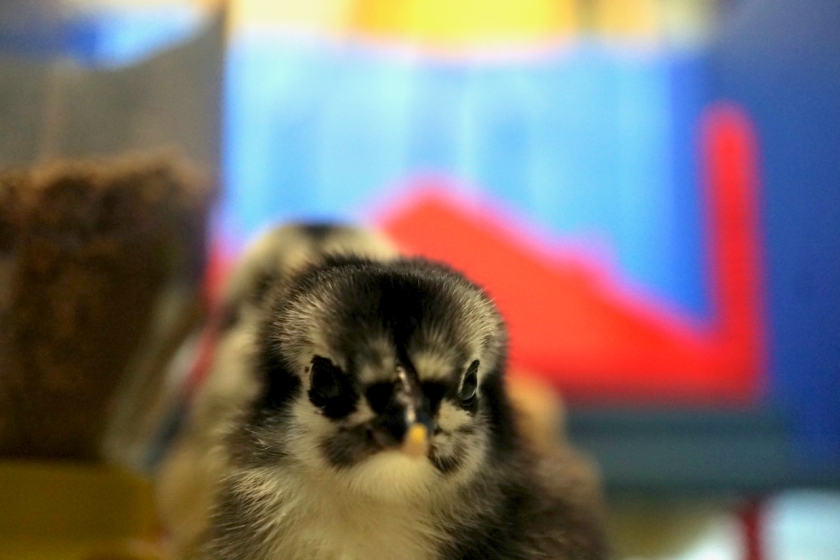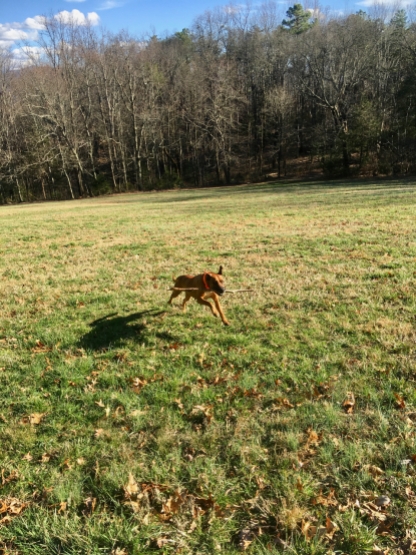by Beth
We’ve never hibernated as hard as we do living in the woods. Maybe being immersed in nature means we feel winter’s signals more. Or maybe it’s because roads here are thin and curvy. Short days and icy nights make staying home an act of self-preservation. Single-car accidents are super popular here. Either way, we’ve had to resist the urge to hunker down because the first spring on the homestead is coming up fast.
We’ve literally waited years to have gardens and animals. After all the hard work it took to establish a home on the land, we couldn’t be more ready to dive into food production.
Well, ready in spirit. There’s been a lot of work to do, but compared to last winter’s homebuilding sprint, it’s been dreamy. Here are the best things we did this winter.
1. We adopted a dog. One of our goals is to rescue a few animals to share all this land with. Adding another dog to guard the homestead seemed like a good start. We’d been sporadically visiting shelters but hadn’t met our dog yet. Then, a picture of a Clover twin popped up on social media marked “urgent.”
 She was at a shelter a few hours away, near where Chris happened to be on a job site. After work, he adopted her.
She was at a shelter a few hours away, near where Chris happened to be on a job site. After work, he adopted her.
We braced for the adjustment period people talk about with shelter dogs. She had excellent manners, but her jangled nerves and nervous habits were supposed to upset the serenity of our home for weeks.
Nobody told Sarah Lee that. Her adjustment period looked like a brown dog snoring on her bed or curled up with Clover, chasing sticks, riding on the golf cart, and sleeping in the sun while we worked in the yard. She’s sweet to BamBam and discerning with strangers. She adores Chris especially. She hasn’t forgotten who sprang her. Meet Sarah Lee, y’all.

2. We prepared for beekeeping. A beekeeping store outside Asheville offers regular education. I braved swervy mountain roads after dark to complete their beginning beekeeping class.

Afterwards, Chris and I spread my notes across the table at datenight dinner and discussed the pros and cons of keeping bees. Cons include being stung, start-up expense, and using up a precious piece of full-sun land.
After being stung by heinous monster hornets and yellowjackets out here, we’re banking on honeybee stings being less frequent and painful than what we’re used to. The other 2 cons are outweighed by the pros: keeping bees aligns with our goals to live responsibly and produce food. 
I’d jotted down 2 additional concerns specifically for Chris: the risk of being stung is high when you’re mowing near them, and keeping bees is sticky.
Chris loves mowing as much as he loathes getting sticky, but for some reason, he’s on board anyway, so we’re going to keep some bees!
Using an app called Sun Seeker – useful for winter planning because it shows the sun’s path throughout the year – we located a flat spot in the orchard with full and morning sun. It’s far enough from the driveway that construction trucks shouldn’t perturb the bees. We’ll build a low platform for the hives and an electric perimeter to keep bears out. Also on the to-do list: paint hive boxes and install our 2 nucs when they’re ready in early spring.
More on bees and what a nuc is here.
3. We started a chicken flock! Meet our Brahmas and Black Langshans, 6 ladies and 1 rooster (hopefully. Sexing chickens is imprecise). We did intentionally buy 1 rooster to protect the hens. He’s the yellow fellow on the left.

He has a fluffy butt. These are feather-legged breeds, and they already have pants!

We’ve never had chickens, so after bee class, it was time to learn about poultry. The farm co-op had a free seminar. We visited neighbors with birds and read books and blogs and online forums.

We commissioned a chicken tractor (a rolling chicken coop) from a local craftsman. It matches barnbungalow and is larger than we thought we needed, which is recommended due to “chicken math,” the concept that people who enjoy chickens begin to collect them uncontrollably.
The tractor – some might call it a chicken rickshaw, or “chicksaw” – has beaucoup predator proofing, so that’s where they’ll eventually live at night. When predator activity is high, they can spend days in here, too. It’s technically large enough for a flock to live in full time, but we’d like them to have more space, so Chris set up a daytime run with an awesome gate.

More wire fence to pull, wheeee.
Fort Chicken Knox is almost ready for business. We still have to proof the gate, run electric fencing around the outside, and install bells and whistles (literally) as deterrents for all the beasts that attack chickens: coyotes, foxes, raccoons, opossums, weasels, dogs, cats, bears, bobcats, skunks, hawks, owls…most of which we see on our trail cameras on a weekly basis.
There’s no rush because chicks have to stay in a “brooder” (a sheltered space with a heater) until they’re bigger and feathered: 2-8 weeks, depending on who you talk to.

The plan had been to start with older birds, close to laying age and reliably sexed, rather than wedge a brooder into barnbungalow to raise chicks that may turn out to be roosters and won’t lay until autumn. We’re a little bougie, so we did try to locate heritage chicken breeders selling “point of lay” birds. We even attended a national chicken show in Knoxville, which turned out to be…weird. And interesting, but not productive. People travel the show circuit with trailers full of show chickens. Few were local. In the quest for heritage chicken breeders in our area, we came up empty handed.
A few up north seemed reputable, but until we have more chicken experience, what do we know about vetting chicken breeders? Instead of trekking to Indiana or Wisconsin, we followed the path of least resistance 10 minutes into town, to the farmers co-op for hatchery chicks.

The self-titled chicken lady at the co-op, Millie, does her best to share her love of poultry with the community. Besides holding classes and talking about chickens as long as you want to, she orders different breeds of day-old chicks from a hatchery each week from January to June.
Millie doesn’t just order the fast-growing designer hybrids you find at Tractor Supply. She brings in heritage and international breeds as well.
Of our shortlist of 3 breeds to try, Millie’s order sheet showed 2 arriving the same day. Kismet. Chicks the same age can be raised in the same brooder. That’s important because we only have space for 1 setup.
Brahmas and Langshans are supposed to be docile and large. Full-grown birds can be heavier than BamBam, big enough that some predators won’t take as much interest. We figure with any luck, these traits will increase their survival rate and our enjoyment.
Hatchery birds are mass-produced versions of their “slow food” heritage cousins. Without wading too far into Joaquin Phoenix territory, it’s true that some hatchery practices are cruel. But hatcheries are a consistent source of hardy, affordable chicks that let more people enter the world of raising birds, leading to fewer people consuming battery products, so called when chickens are confined to tiny cages connected like an artillery battery, which is horrifyingly standard in our chicken industry.
Any doubts about going the hatchery route were smoothed over by Millie’s enthusiasm and all the neighbors who reported good experiences with co-op birds. I asked Millie to order us a Buff Brahma rooster (edit: we later realized they gave us a Light Brahma rooster instead, which means he’s white instead of brown, but we love him either way) to be delivered with the pullets (lady chicks) and was wildly distracted by chicken thoughts for 2 weeks before they arrived.
I *may* have gone to the co-op once just to make sure Millie had my number down correctly so she could call as soon as the chicks arrived. The brooder was ready days in advance, with the heater pre-heated and drinking water at room temperature when the chicks got home.
 Attention to detail doesn’t guarantee these babies will have long lives, or that they’ll live to egg-bearing age this fall. Chickens face risks at every age. Despite that reality, I don’t remember the last time I’ve been as excited about anything as I am about chickens.
Attention to detail doesn’t guarantee these babies will have long lives, or that they’ll live to egg-bearing age this fall. Chickens face risks at every age. Despite that reality, I don’t remember the last time I’ve been as excited about anything as I am about chickens.
That’s saying a lot, because I get delirious about wildflower season in the Smokies every year and giddy about the first cup of coffee each morning.
There was something different about waiting for chicks. I don’t know why. I hope I remember this feeling when the rooster starts crowing at 4 a.m.
4. We built stone garden beds. Like bees, gardens thrive on flat, sunny ground. It took several seasons to decide on this patch. It’s close to the barn (convenience to the kitchen is always nice) but out of the way of daily activities and occasional powerline maintenance. After watching it for a full wet season, we know this spot won’t wash out in heavy rain. It easily accommodated these 4 x 12′ beds with minimal site preparation; we only had to move a stack of supplies and level the ground slightly with the tractor bucket.

It was amazing to work with our natural resources. Our soil is full of rocks, and I’ve been dying to dot the property with stack-rock structures. Stacking rock is back-breaking work, but the result is environmentally friendly and historically appropriate. Our acreage is lined with remnants of dry-stack (no mortar) stone walls from the 1800s.
We usually use new materials to build things to last a long time and look nice. But homesteading is supposed to be about living off the land, and if long-lasting and good-looking are our main criteria, stone fits the bill.

Chris was reluctant about using stone. The story of his winter has been his j-o-b, preparing for a new position while training other people to do his job. Between 16-hour days, thousands of travel miles, and 7 days a week on the phone, the idea of learning to build with a new material wasn’t appealing.
He had offered a few months back to build a stone flower box in front of barnbungalow, and I’d been diligently gathering rocks from all over our land, leaving them by the barn. The fact that I’d already schlepped a literal ton of rock to the work site helped convince him to give rock boxes a try.
Nothing about this was easy, and oddly, YouTube wasn’t much help. Dry-stack rock may have the smallest YouTube presence of anything we’ve tried out here.

They don’t look as strong as they are. We can lean on them and not knock anything over. However, part of the beauty of dry-stack rock is it’s infinitely tweakable and re-stackable.
We’ve had enough rock fun for a while, so Chris used wood on the boxes in the front, which follows the lines of the barn nicely anyway.

If all goes well, this box will be ablaze with wildflowers and happy pollinators by  summer. I’ve been making trips to Eden Brothers in Arden, NC, to stock up on seeds. It would be easy enough to order seeds online, but Arden isn’t too far away, and it’s fun to walk around the warehouse and talk to their botanist.
summer. I’ve been making trips to Eden Brothers in Arden, NC, to stock up on seeds. It would be easy enough to order seeds online, but Arden isn’t too far away, and it’s fun to walk around the warehouse and talk to their botanist.
Next up: soil delivery and amendments, and a small rock border for a monarch garden where the sinkhole used to be. Then, planting!
Honorable mention: We watched Homestead Rescue, a reality show where the cast helps struggling homesteads. Besides giving cool tips to solve some of the riddles we face out here, the show spotlights a core culprit of homestead failure: taking on too much, too fast. Watching others’ struggles reminds us why it took so long to get here and makes us feel good about our patience.
Keeping animals and gardens were major reasons we wanted land, but despite our restlessness to get started, we’re glad we didn’t rush it. It was important to wait until we could be onsite to keep everything safe and have the head room to enjoy the experience. Also good to have running water first.
There’s much more to do – like keep everything alive and build a dome – but reaching this season was a massive accomplishment. Here’s to good vibes for a prosperous spring. Thanks for reading.





Great accomplishments, Beth and Chris! It is so interesting to see all you’re doing and how excited you are about it.
LikeLiked by 1 person